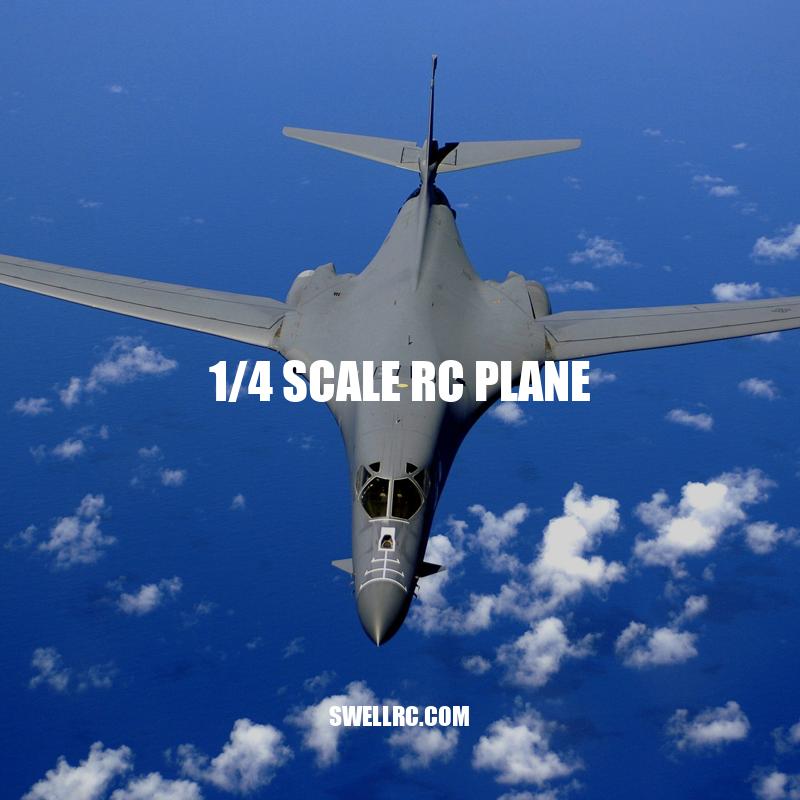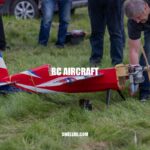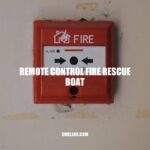Exploring 1/4 Scale RC Planes: Design, Flying, and Future Advancements
1/4 scale RC planes are one of the most sought after products in the RC hobbyist community. These planes are miniature replicas of real-life airplanes, and their popularity has grown significantly in recent years. One reason for this is the fact that they offer an incredibly realistic flying experience, which is hard to come by with other types of RC aircraft. These planes are also highly detailed and come with a range of features that make them feel like real aircraft. For instance, they are designed with retractable landing gear, working flaps, and even LED lights that mimic the look of a real airplane. Moreover, modern advances in technology have made it easier for hobbyists to build and operate 1/4 scale RC planes, which has expanded the audience for this type of aircraft. With so many compelling reasons to own and fly a 1/4 scale RC plane, it’s no wonder that these miniature marvels have become such a hit in the RC world.
Design and Construction
The design and construction of 1/4 scale RC planes is complex, and hobbyists need to pay attention to everything from the materials used to the final balancing of the aircraft. Here are some key points to consider:
- Balsa wood and foam are the most popular materials used for building 1/4 scale RC planes, with carbon fiber also emerging as a favored choice for durability.
- Designing and constructing a 1/4 scale RC plane can be done either from scratch or by using pre-built kits that come with the necessary parts and instructions.
- The weight of the plane plays a significant role in how it will fly, so balancing and aerodynamics must be carefully considered during the construction process.
- Some hobbyists use computer-aided design (CAD) and 3D printing technologies to create custom parts and components for their 1/4 scale RC planes, allowing for greater customization and creativity.
- Several websites offer resources for building and designing 1/4 scale RC planes, including plans, kits, and parts. Websites such as RC Universe and RC Groups are useful for finding tutorials, advice from experts, and online forums where hobbyists can share tips and information.
Overall, the design and construction of 1/4 scale RC planes is an intricate process, but the end result is a visually stunning and highly functional miniature airplane that boasts impressive flying characteristics. With the right tools, parts, and know-how, hobbyists can take on this challenge and experience the thrill of building and flying their own 1/4 scale RC plane.
What scale are RC airplanes?
RC airplanes can come in different scales, but to be considered Giant Scale by the IMAA, an RC airplane must have at least an 80-inch wingspan or be a true quarter scale aircraft. Biplanes must have a minimum of a 60-inch wingspan. For more information on RC airplanes, you can check out websites such as Horizon Hobby or Tower Hobbies.
To get a 1/4 scale RC plane off the ground and into the air, hobbyists must have the proper hardware and electronics in place. Here are some key points to consider:
- The servos are small motors that control the movement of the control surfaces on the plane and are essential for making it maneuverable.
- The receiver connects to the transmitter and receives the signals that control the movements of the servos.
- Control surfaces, such as the ailerons and elevators, are controlled by the servos and allow for directional changes and adjustments in altitude.
- The transmitter is the handheld device that sends signals to the receiver and can have different channels to control different servos on the plane.
- Some 1/4 scale RC planes come with built-in landing gear, while others require an additional component to be added depending on the flying location or the design of the plane.
- Improvements in technology have made it possible for 1/4 scale RC planes to have features like onboard cameras and transmitters, allowing for livestream or recorded video footage from the plane.
- Several websites, such as HobbyKing and Tower Hobbies, offer a wide range of hardware and electronics necessary for 1/4 scale RC planes, including servos, receivers, transmitters, and batteries. It is important to buy from reputable retailers to ensure proper functionality and safe flying.
Here is a table comparing some of the different types of servos used for 1/4 scale RC planes:
| Servo Type | Torque | Speed | Price (USD) |
|---|---|---|---|
| Standard | 45-60 oz-in | 0.20-0.30 sec/60° | $10-$20 |
| High Torque | 80-120 oz-in | 0.16-0.22 sec/60° | $30-$50 |
| Digital | 100-300 oz-in | 0.08-0.15 sec/60° | $50-$100 |
In conclusion, selecting the right hardware and electronics is crucial for the success of a 1/4 scale RC plane flight. With advancements in technology, today’s hobbyists have access to a variety of tools and resources that make it easier than ever to build and fly their own model aircraft.
What scale are RC models?
The most common size or scale of an RC model is 1:8 scale, while mini-RCs can come in even smaller scales such as 1:28 and 1:64. It’s important to note that the scale of an RC is relative to its full-size counterpart, so two vehicles of the same scale can vary significantly in size. For more information on RC models and their scales, check out websites such as Horizon Hobby or Tower Hobbies.
Flying and Maintenance
Once the hardware and electronics have been set up for a 1/4 scale RC plane, there are important flying and maintenance considerations to keep in mind. Here are some tips:
- Find an open and safe flying location, such as a field or park, away from people and buildings.
- Make sure the weather is appropriate for flying, with good visibility and low winds.
- Before flying, perform an inspection of the plane to check for any loose parts, damage or worn out components. Proper fixing must be undertaken before flying.
- Keep the plane balanced and ensure the center of gravity is correct to avoid crashes or instability in flight.
- Practice safe flying techniques, such as keeping the plane at a safe distance from people and objects and avoiding flying in restricted airspace.
- After flying, do a thorough check of the plane and perform any necessary maintenance or repairs.
- Store the plane in a clean and secure location to minimize the risk of damage or dirt buildup.
Here are some additional upgrades that can enhance the flying and maintenance experience:
- Adding landing gear, such as retractable wheels or floats, can make it easier to take off and land on different surfaces.
- Installing a camera on the plane can provide an exciting and unique perspective on the flight experience.
- Consider adding LEDs or other lighting systems that can improve visibility during flight and make the plane more attractive at night.
- Several online communities, such as RCGroups and RC Universe, offer resources and experienced advice for maintenance and troubleshooting issues.
In conclusion, proper flying technique and maintenance are essential to keep 1/4 scale RC planes in top condition and ensure safe and enjoyable flights. Incorporating additional upgrades and joining experienced communities can enhance the overall flying experience and knowledge sharing.
What does aircraft maintenance include?
Aircraft maintenance includes repairing and replacing various components of an aircraft, such as wings, brakes, and electrical systems. Mechanics use both hand and power tools to perform these tasks and examine replacement parts for defects. The process involves carefully following maintenance manuals to identify the correct repair procedures. No relevant website or product information is required for this answer.
1/4 scale RC planes range in price, depending on the complexity of the plane and material used in construction. Here are some points to consider:
- Budget-friendly planes made from foam with basic hardware and electronics can cost around $200 – $300.
- Mid-range planes made from balsa wood with more advanced hardware and electronics can cost upwards of $500 – $600.
- High-end planes made from carbon fiber with top-of-the-line hardware and electronics can cost $1000 or more.
For hobbyists on a tight budget, purchasing a used 1/4 scale RC plane may be a good option. Here are some places to look:
- Online classifieds like Craigslist and Facebook Marketplace can be a great resource for finding used planes in your area.
- Online hobbyist forums like RCGroups and RCGiant could be a good place to search for used 1/4 scale RC planes within their classified sections.
- RC model shops may sell used planes on consignment on behalf of other hobbyists.
If you’re looking to purchase a new 1/4 scale RC plane, here are some reputable retailers:
- Hobbyking
- Tower Hobbies
- HobbyZone
In conclusion, the cost of owning a 1/4 scale RC plane can vary depending on the design, material, and overall complexity of the plane. There are options available for budgets of all sizes, including purchasing used planes from classifieds or online hobbyist forums and shopping at reputable retailers for new planes.
How much does making an RC plane cost?
Making an RC plane can cost around $400 considering the cost of the materials needed for the build. However, it is important to note that additional expenses may be incurred for basic tools, glues, and building boards which may cost around $100. It is also suggested to replace low-quality components that may come with the kit. There are websites such as HobbyKing and Tower Hobbies where you can find a wide range of RC plane kits and accessories.
Future of 1/4 Scale RC Planes
As with any technology, 1/4 scale RC planes are constantly evolving with new advancements and improvements. Here are some potential directions for the future of 1/4 scale RC planes:
- Improved battery life and increased flight range to enable longer flights.
- Advancements in automation technology to enable planes to fly without a pilot’s manual control.
- Enhanced camera and video capabilities to enable more engaging and higher quality video recordings of flights.
- Integration with virtual reality and augmented reality technology to enhance the flying experience and provide new opportunities for training and simulation.
While these are all exciting possibilities, there are also some challenges that may impact the future of 1/4 scale RC planes. One such challenge is the increasing regulation of drones, which could extend to RC planes as well. The Federal Aviation Administration (FAA) has put regulations in place to ensure the safety of airspace, including unmanned aircraft systems. It’s possible that future regulations could impact the ability for hobbyists to operate 1/4 scale RC planes in certain areas or above a certain altitude.
However, despite these challenges, the future looks promising for 1/4 scale RC planes. As technology continues to evolve, there will be new opportunities for hobbyists to build and operate these planes in unique and exciting ways. We encourage hobbyists to continue exploring the possibilities of 1/4 scale RC planes and sharing their experiences with others.
What advancements must be made before a fully electric aircraft becomes a practical means of flight?
Before a fully electric aircraft becomes a practical means of flight, several technological advancements must be made. Firstly, new battery designs that have not yet been developed are required. Another crucial requirement is improving cooling technologies, high power density electronics, and high-temperature resistant lightweight materials. Currently, no batteries on the market can power a commercial passenger flight. Despite this significant challenge, several collaborations between aviation companies and battery manufacturers are working to develop new and more efficient battery designs for aircraft. According to Forbes, industry experts predict that we will see the introduction of fully electric planes serving short-haul flights, such as regional air transport, in the next 10 to 20 years.
Conclusion
In conclusion, 1/4 scale RC planes offer a unique and exciting opportunity for hobbyists to build, fly, and maintain their own realistic aircraft. With the right materials, hardware components, and flying techniques, 1/4 scale RC planes can provide hours of fun and entertainment. As technology continues to evolve, there will be more opportunities for hobbyists to explore new advancements and improvements in this field.
Whether you are a seasoned RC hobbyist or just starting out, 1/4 scale RC planes are a rewarding and satisfying challenge that can provide endless hours of entertainment. By following the tips and guidelines provided in this article, you can build and operate your own 1/4 scale RC plane with confidence and skill. Remember to always practice safe and responsible flying techniques, and share your experiences with others to encourage growth and development in this exciting hobby.



